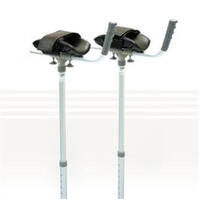Dynamic Forearm Crutches
Universal shaped handgrip forearm crutch.
Description
Forearm crutches, also known as elbow crutches or Lofstrand crutches, are adjustable. They offer several benefits for individuals who require assistance with walking.
Here are some of the key advantages:
Improved Gait:
Forearm crutches are designed to facilitate a more natural walking pattern, which can improve gait efficiency and speed. They allow for better arm swing and leg placement during walking.
Greater Stability and Control:
The cuff that wraps around the forearm provides increased stability and ensures that the crutch stays aligned with the arm, allowing for better control when maneuvering.
Weight Distribution:
Unlike underarm crutches that transfer weight to the underarm area, forearm crutches distribute weight more evenly through the hands and arms, reducing the risk of underarm discomfort and nerve damage.
Enhanced Mobility:
They allow for a wider range of movement than underarm crutches and can be particularly helpful for navigating stairs and tight spaces.
Ergonomic Design:
Many forearm crutches come with ergonomically designed handles that conform to the shape of the hand, which can reduce hand and wrist fatigue.
Increased Independence:
Users often find that forearm crutches allow for greater independence in daily activities because they require less upper body effort than underarm crutches.
Long-Term Use:
They are often recommended for individuals who will need crutches for a longer period, as they promote better posture and are more suitable for extensive use.
Customizable Fit:
The height of the crutches and the position of the forearm cuff can usually be adjusted, providing a customized fit for the user.
Compact and Lightweight:
Forearm crutches tend to be more compact and lighter than underarm crutches, making them easier to transport and use on the go.
Less Upper Body Strain:
Because forearm crutches are used with a straighter elbow, they can minimize strain on the upper body and reduce the risk of crutch palsy, which is a condition associated with underarm crutches.
Suitable for Varied Terrain:
Users typically find it easier to maintain stability on uneven ground with forearm crutches due to the direct load-bearing down the shaft of the crutch.
Forearm crutches can be particularly beneficial following joint replacement surgery, such as hip or knee arthroplasty.
Here's more information regarding their use in the postoperative period:
Enhanced Support During Rehabilitation:
Forearm crutches provide the necessary support to allow patients to begin mobilizing soon after joint replacement surgery, which is crucial for promoting blood flow and reducing the risk of blood clots.
Facilitate Partial Weight-Bearing:
As the new joint heals, patients are often advised to limit the amount of weight they place on the affected limb. Forearm crutches are ideal for partial weight-bearing as they can help distribute the person's weight more effectively than underarm crutches.
Promote Proper Posture:
Maintaining proper posture is essential after joint replacement to avoid undue stress on the new joint. Forearm crutches encourage an upright posture and proper body mechanics during walking.
Adjustable for Progressive Rehabilitation:
As the patient's strength and mobility improve, forearm crutches can be adjusted to gradually increase weight-bearing on the recovering joint, facilitating progressive rehabilitation.
Allows for Active Muscle Engagement:
Using forearm crutches involves the active engagement of the upper body muscles, which can help maintain muscle tone and strength that benefits overall rehabilitation.
Reduced Risk of Complications:
Proper use of forearm crutches can reduce the risk of dislocation or other complications after hip or knee replacement by helping to control movement and prevent falls.
Increased Autonomy:
As the patient regains mobility, forearm crutches can provide the confidence and autonomy needed to perform daily activities independently while still protecting the new joint.
Suitable for Long-Term Use:
If extended support is required, forearm crutches are often more comfortable for long-term use than underarm crutches, which can cause discomfort or injury with prolonged use.
Precise Control:
The direct handgrip and forearm support of these crutches allow for precise control when navigating different surfaces, steps, or obstacles, which is beneficial for someone recovering from surgery.
Encourages Active Recovery:
Forearm crutches can enable patients to become active participants in their recovery by allowing for a more extensive range of motion and mobility exercises during the healing process.
It’s important for patients post-joint replacement to receive instruction from a physical therapist on the proper use of forearm crutches. The therapist will ensure that the crutches are correctly sized and that the patient is comfortable with them, as well as teach the patient the appropriate weight-bearing and gait patterns to use during recovery.
Forearm crutches are particularly beneficial for individuals who have good core strength and upper body control but still require the additional support of a walking aid. As with any assistive device, it’s important to receive proper training from a healthcare provider to ensure correct usage and to prevent injury.
Specifications
Crutch size: Child
- Code: 15-0102
- Approximate patient height: 4' 0" - 5' 3"
Crutch size: Regular
- Code: 15-0103
- Approximate patient height: 5' 4" - 6' 1"
Crutch size: Large
- Code: 15-0104
- Approximate patient height: 5' 6" - 6' 3"
Others:
- Weight capacity: 180kg
- Warranty: 12 months
- Rubber tip/ferrule size: 22mm
| SKU | P-12173 |















